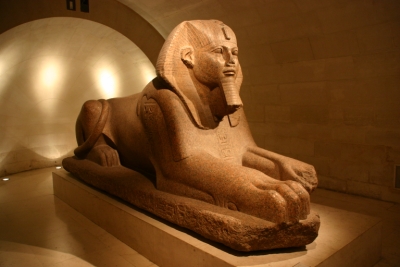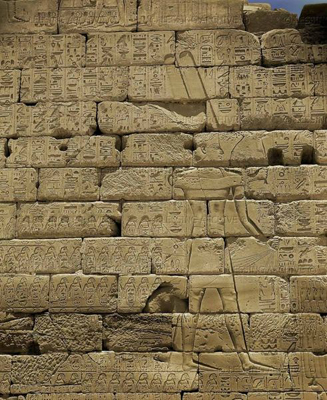Un jour, Une Œuvre,
07/04
The Great Sphinx of the Louvre museum
Great Sphinx
the features of King Amenemhat II A 23 Sully Room 1
The Great Sphinx, is monstrous
the body of a lion and head of a king was found at Tanis, the Greek name of Soan,
mentioned in Numbers 13:22.
The name of Pharaoh Shishak appears on the sphinx
The name of Pharaoh Shishak 1 (Shishak) appears on the left shoulder. The king of Egypt is mentioned seven times in the Bible. It is to him that Jeroboam fled to escape the wrath of King Solomon. - 1 Kings 11:40. AE1
Shishak, king of Egypt is mentioned in the Bible
Etchings on the wall of an Egyptian temple
Karnak (No. AE2 in Jeremiah 46:25)
lists many cities conquered by Shishak Judean.
Only the Bible recounts the invasion
(1 Kings 14:25-28).
The document also refers to the "field of Abraham." This is the earliest mention of the patriarch in the Egyptian texts. AE3
Also inscribed on the Louvre Sphinx
is the name of King Merneptah, the 13th son of Ramses II. He would have reigned from 1213 to 1203 BC, which corresponds to the end of the period of the judges in Israel.
https://cojs.org
A monument celebrating his victories, is kept in the Cairo Museum, it contains the oldest evidence besides the Bible, of the existence of a people named Israel.
The last two lines say: "Ascalon is taken, Gezer is seized. Israel is destroyed; its seed is no longer available."
(The Jews of Egypt, Ramses II to Hadrian, Paris, Wandering, 1991, p.16).
On line 27, the association of the last three signs, a missile, then a man and a woman, both seated, designate Israel as a foreign people.
"Israel is laid waste, his seed is no more"
(The Bible in the British Museum, document 14, p. 44)

It can hardly be suspected of supporting the Egyptians or the Bible to have invented a people so curious for their own glorification.
The Bible mentions over 700 times Egypt
The Bible mentions over 700 times Egypt
and its inhabitants.
It is generally known by the name
Mizraim (Genesis 50:11, TMN note)
This suggests that the descendants of
this son of Ham were predominant in this region,
also known in some psalms the "land of Ham."
As for the name of Pharaoh it is the Bible
who first made us aware of him. AE4
Pharaoh means "great house".
By extending its use came to refer to the sovereign who resides in the Palace;
identification still present and comparable to "The White House", "The Elysee".
The first document where the title Pharaoh is juxtaposed to the proper name of the king during the reign of Shishak, a contemporary of Solomon.
In the Bible, we find the same juxtaposition in the case of Pharaoh Neko (2 Kings 11:29 p.m.) and Pharaoh Hophra (Jeremiah 44:30)



